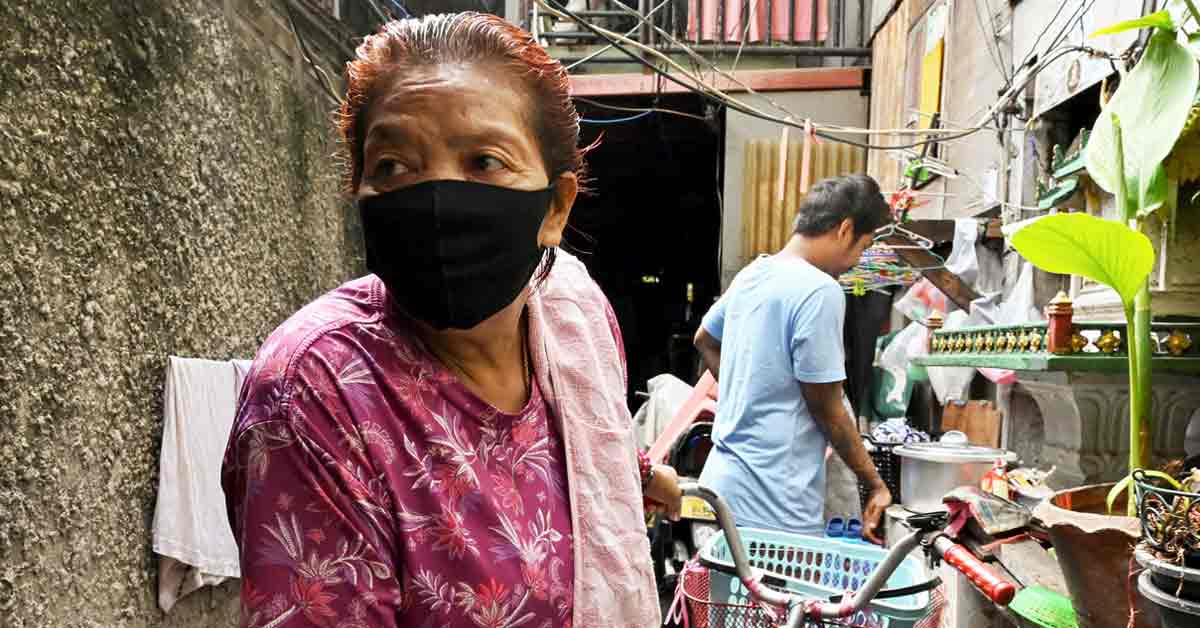In April last year, Unyakarn Booprasert, a Thai cleaner, tried to commit suicide in front of the Ministry of Finance’s building with rat poison as a “protest”, as what she was going through “happened to many people.”
“I completely ran out of money. I called my friends and relatives. Everyone had no money,” Booprasert explained. She was left to starve, splitting one packet of instant noodles between three meals.
She was desperate for the money promised by the government, to be paid over three months, under its No One Left Behind cash relief scheme.
“The financial aid of THB 5,000 (US$150) that I was waiting for hadn’t arrived. They didn’t tell me at all when I would receive it,” she said.
She then learned that she was among millions of applicants who did not qualify for the aid, which prompted her to plead her case to the authorities.
“When I got to the Ministry of Finance, sure enough, they didn’t listen,” said the 59-year-old. “From their actions, a poor person was similar to a pig or a dog, an animal with scabies.”
Following her suicide attempt, the authorities looked into her case again and decided that she was eligible for the relief, reported an Asian news agency, which also produced a documentary featuring Booprasert’s suicide story.
Thailand, also known as the Land of Smiles, has the highest suicide rate in Southeast Asia. It is estimated that on average, at least one attempted suicide occurs every 10 minutes.
Before the pandemic, the media stated that there are some 53,000 suicide attempts in the ASEAN member state every year. World Health Organisation (WHO) data in 2019 showed that the Land of Smiles’ annual suicide rate was 14.4 per 100,000 of the population, while the global age-standardised average is 10.4 per 100,000.
Unfortunately, the COVID-19 pandemic has exacerbated the suicide epidemic in Thailand.
Suicide In A Pandemic
Antonio L Rappa, Associate Professor at the Singapore University of Social Sciences cited deep-seated cultural and economic reasons to Thailand’s high suicide rate. He noted that Thais’ “long history of being warriors” has imbued their psyche with the “idea of death.”
Rappa also added that Thai’s protest culture also means that the people may be willing to die “as a means to mark their cause.”
Economic reasons, relationship problems, alcohol, and drug abuse, and financial difficulties are some of the biggest factors that lead people to take their own lives.
The current pandemic has caused a rise in unemployment, shuttered businesses, and loss of livelihoods. For the 11 million people in Thailand who live below the poverty line, things are even grimmer during COVID-19 pandemic.
According to Thailand’s Department of Mental Health, the suicide rate has increased by 22 percent in the first six months of 2020 during the COVID-19 crisis, compared to the same period in the previous year.
Varoth Chotpitayasunondh, the Spokesman for the Department of Mental Health told the media that the current crisis in Thailand is rather similar to a financial crisis 23 years ago, called the Tom Yum Kung crisis, which had a quite similar impact on the economy as the COVID-19 pandemic.
He noted that during that period of time, the number of people who died by suicide increased around 20 to 25 percent compared to the previous year.
Millions of Thais have lost their jobs amid the pandemic, especially those in the tourism industry where more than 500,000 workers have been laid-off in 2020 due to the economic impact of the coronavirus. Earlier this year, the Tourism Council of Thailand said that the country could see a million more jobless tourism workers in the first quarter of 2021.
It was reported that one in 13 workers in Thailand have lost their job.
With millions without incomes, suicide hotlines in the country have seen a spike in call volumes from those struggling in the pandemic. Panomporn Phoomchan, Director of charity group Samaritans of Thailand said that most calls are related to concerns about financial problems.
Unfortunately, the increase of suicide cases during the pandemic is not only exclusive in Thailand. Recently, Philippine media reported that suicide incidents in the archipelago rose by 25.7 percent in 2020 compared to the previous year.
Philippine Statistics Authority (PSA) data revealed that some 3,529 cases of intentional self-harm were recorded last year, compared to 2,808 recorded in 2019.
In Japan, where more women have lost their jobs, 6,976 women took their lives in 2020, nearly 15 percent more than in 2019.
Those in need of help can contact local hotline services such as the Thai Department of Mental Health hotline at 1323, Befrienders for Malaysians, National Center for Mental Health for Filipinos and, the Samaritans of Singapore for Singaporeans, among others.
Related Articles:
